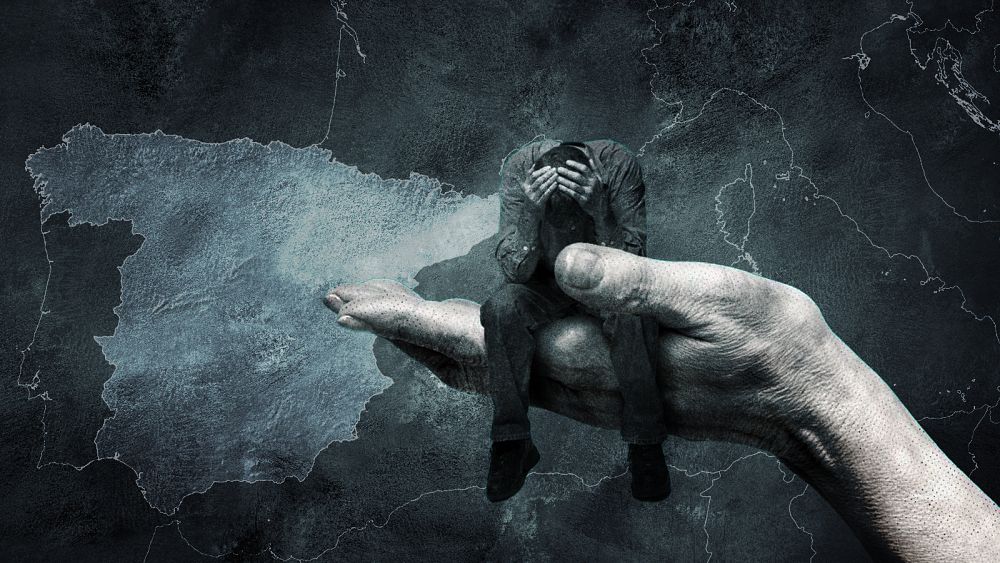More Spaniards have killed themselves in 2022 than in any other year since records began. But why?
Just one month after Spain created its first suicide prevention helpline in May 2022, its workers handled nearly 15,000 calls, according to data from the Ministry of Health.
The flood of calls shows the need for help in a society where mental health is still taboo. However, with many Spaniards pushed to their limits by the COVID pandemic, the topic has forced itself into public debate.
Despite measures such as helplines being introduced to try and curb the rising number of suicides in the country, things are not getting any better.
Spain reported in 2022 its highest number of suicides since records began.
Over 4,097 people committed suicide, 2.3% more than in 2021. Figures published annually by the National Statistics Institute show an increasing trend since 2018.
“This is a real social emergency, reversing the trend must be a matter for the country,” Andoni Anseán, president of the Spanish Foundation for Suicide Prevention, told Euronews.
Lack of a national plan, shortage of specialized health workers in the health system and little follow-up for people who attempt suicide are issues highlighted by experts.
But is this enough to explain why suicides are on the rise in the southern European country?
Parents are at risk
While the death rate from the disease has fallen – because the treatment has improved – the suicide rate has continued to increase.
According to the president of the Spanish Foundation for Suicide Prevention, official figures may not reflect the reality of the country, as more deaths occur than are actually reported in official data.
This is why the elements of the study of suicide remain a mystery in Spain.
Alejandro de la Torre, member of the Center for Biomedical Research Network – Mental Health, conducted one of the most recent studies published in the country on the evolution of suicide mortality data over the past 20 years.
Researchers detected the two most common profiles.
“The first is a group of people who are highly premeditated and depressed. They have long thought of suicide and tend to leave everything tied up, including writing farewell notes.”
“The second group is impulsive. These are people who, when they have very strong emotions, go overboard and assume that they will lower their emotional level through a suicide attempt,” added de la Torre.
Reviewing statistics by age group, psychologists found that the older the age group, the greater the risk.
The group of Spaniards over 40 is equivalent to half of those who have committed suicide.
More than 13.8% are between the ages of 25 and 39, while only 5% of all suicides are committed by young people between the ages of 10 and 24.
“Young people are the ones who think about suicide the most and try to do it. However, it is the parents who are most successful,” explains de la Torre.
These numbers could stem from a failure of preventive measures and a lack of support from the public health system, according to experts.
“Having the first psychological consultation is not a problem, but managing to get more appointments is a problem. You may be able to get your first medical appointment in five days, but then it can take months for the next one,” says Anseán.
“If it’s an anxiety or depression issue, they might even give the patient an appointment for next year,” he adds.
What is the example of European Hungary?
Interestingly enough, Europe looks to Hungary when it comes to suicide prevention.
The country has managed, over the years, to reverse the trend and reduce the number of suicides in the country.
Hungary had the highest suicide rate in the world until 1992. Since then, the rate has stabilized and from 2000 to now it has halved from 3,269 this year to 1,561 in 2021.
A study published in BMC Psychiatry says the Eastern European country is a success story.
They pointed to a shake-up in the health system that involved increasing the number of psychologists – from 95 to 139 in each department – and creating more suicide prevention helplines.
This is one of Spain’s main problems, according to experts.
“We are far below the European ratio of health professionals. The first three months after a suicide attempt is considered the most critical period. This is why we need more psychologists and psychiatrists to carry out appropriate follow-ups,” said de la Torre.
The expert emphasizes that in relation to Europe, Spain does not have a high suicide rate.
“This country reaches 8.4 per 100,000 population, while in Scandinavian countries it is closer to 11 per 100,000 population”.
However, what is really worrying for de la Torre is that these tariffs cannot be dammed.
#Social #emergency #Spains #suicide #rate #record #high
